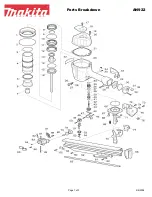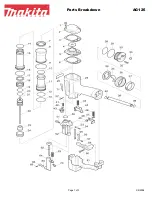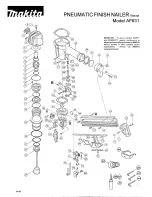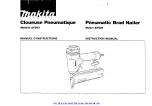
SINGLE-FIRE
When the switch is set to single-fire mode, the tool will not drive a second fastener until the
trigger is fully released and pulled again and the contact trip is pressed against the workpiece.
RAPID-FIRE
Pull the trigger fully and keep it depressed to ensure proper rapid-fire operation.
When the switch is rotated to rapid-fire mode, the tool can drive fasteners continuously. A
fastener will be fired each time the contact trip is pressed against the workpiece, as long as the
trigger is maintained in the pulled position.
OPERATION
Appropriate personal protective equipment is to be worn.
Inspect the tool before operating.
Determine that the tool is in proper working order.
An improperly functioning tool must not be used.
Always assume that the tool contains fasteners.
Do not point the tool toward yourself or anyone whether it contains fasteners or not.
Do not actuate the tool unless the tool is placed firmly against the workpiece.
Respect the tool as a working implement.
No horseplay.
Do not hold or carry the tool with a finger on the trigger
Do not load the tool with fasteners when any one of the operating controls is activated.
Do not remove, tamper with, or otherwise cause the tool operating controls to become
inoperable.
Do not operate a tool if any portion of the tool operating controls is inoperable,
disconnected, altered, or not working properly.
1. Add one drop of the air tool oil into the air inlet.
2. Empty all fasteners from the magazine.
3. Connect the tool to an air compressor using a 3/8”
I.D. hose. Make sure the hose has a rated
working pressure exceeding 200 PSI (13.8 bar).
4. Load the fasteners into your tool following the instructions of
“Loading The Fastener” in this manual.
5. Test for proper fastener penetration by driving nails into a
sample piece of wood. If the fasteners do not achieve the
desired penetration, adjust the air pressure to a higher setting
until the desired penetration is achieved. Do not exceed 120
PSI (8.0 bar) at the tool.
MAINTENANCE
Disconnect the air tool from the air compressor before adjusting, clearing jams,
servicing, relocating and during non-operation.
Only qualified personnel shall repair the tool and shall only use parts or accessories
that are supplied or recommended by the tool manufacturer.
The employer shall ensure that tools which require repair are not further used before
repair. Tags and physical segregation are recommended means of control. OSHA’s
General Industry and Construction regulations require the use of tags.
The employer is responsible for ensuring that the tool maintenance instructions are
available to the appropriate personnel.
The employer is responsible for the proper maintenance of all tools in its possession.
LUBRICATION
Disconnect the air supply from the tool before
lubricating.
Your tool requires lubrication before using it for
the first time, and requires a maximum of one
drop daily before use.
Wipe off excessive oil at the exhaust. Excessive
oil may damage the o-rings of tool. If an in-line
oiler is used, manual lubrication through the air
inlet is not required on a daily basis.
Turn the tool so the inlet is facing up and put one
drop of air tool into the air inlet. Test the tool after
the oil is added.
Never use detergent oil or additives. Use
pneumatic tool oil only.
8
9

























